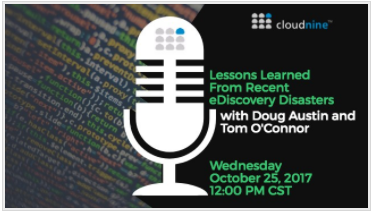Editor’s Note: If you read our blog regularly, you know that we frequently reference my friend and CloudNine colleague Rob Robinson’s excellent blog, Complex Discovery for various industry information, including quarterly business confidence surveys, eDiscovery software and service market “mashups” and information about industry mergers and acquisitions (among other things). We’ve been discussing aspects of on-premise and off-premise eDiscovery offerings quite a bit lately (including this recent webcast conducted by Tom O’Connor and me a few weeks ago) and Rob has written a terrific article on the subject which he has graciously allowed me to publish here. This is the third part of his multi-part article (parts 1 and 2 here and here) – we will publish it in a series over the next couple of weeks or so. Enjoy! – Doug
Considering Capability
“Technology is a useful servant but a dangerous master.” Christian Lous Lange
Once the security of a potential solution has been considered, the next reasonable area of examination and evaluation is that of capability. Assessing capability is just determining whether or not a solution can accomplish the necessary tasks required in an eDiscovery effort. While there are not always discernible differences in the capabilities of on-premise and off-premise offerings, there are some characteristics to consider as they may be indicators of the ability of a solution to meet actual needs as opposed to perceived needs. Some of these characteristics include maturity, integration, and automation.
The maturity of an offering is important as it helps inform one on how long an offering has been in the market and if it might or might not contain the latest and most efficient technology to accomplish eDiscovery tasks. However, maturity becomes a factor only when it contributes to the inability of a solution to perform the task for it is being asked to complete. If a mature solution is incapable of completing a task today based on lack of functionality or in the near-term based on discontinued support, then it might not be the most appropriate solution from a purchase protection perspective. On the other hand, if it works today and will be maintained in the future, it seems reasonable that the mature offering should not be excluded as a potential choice solely based on the time it has been available on the market.
When discussing maturity, many eDiscovery professionals often and wrongly categorize maturity as legacy and equate legacy with insufficiency. This generalization may be true in some cases. However, some of the most mature offerings in the marketplace today are still the most effective at accomplishing specific tasks. Given that some of the most mature offerings are on-premise, there may be situations where the most appropriate choice for a particular task might be accomplished with an on-premise solution. It is easy to react to the glittering generality of considering all mature technology as legacy and therefore not as good as newer offerings. However, make sure that judgment on capability is first and foremost on the ability of the offering to complete required tasks and not on the time an offering has been in the marketplace.
Integration of an offering is also an important selection characteristic as it may indicate the potential for time and cost efficiencies lacking in non-integrated solutions. For example, offerings that have internal or external technology integration points for ingestion, processing, and review tasks might be more desirable than non-integrated offerings. However, integration without appropriate capability is not acceptable as one cannot be successful in eDiscovery if one cannot perform required tasks.
Automation in eDiscovery should be considered in the same way integration is considered. If automation is available, then it may be desirable over non-automated solutions based on time and cost savings delivered in task completion. However, automation ceases to be important if the tasks being automated are unable to complete required tasks. An example of this would be the automation of ingestion and processing in an offering. Automation of these tasks may be beneficial for certain data types, but if the data types that need to be processed cannot be processed due to lack of system capability, then the time efficiencies of automation may be negated by the time required for manual processing.
Additionally, not all offerings are created equal in their capability to accomplish tasks on large volumes of data. This volume limitation on an offering’s capability is not one usually found in a provider’s software marketing materials or user’s guides, but it is usually well known by those who have implemented specific solutions that fall short in this capability. In fact, even some of the newer, cloud-based off-premise offerings fall short in this area, so short that they position their offering for best use in small and medium cases sizes. This type of data volume capability limitation is becoming increasingly important as the challenge of increasing volumes of data is regularly noted as one of the top concerns of eDiscovery professionals.
Quick Takeaway: In examining the capability of an offering, the first focus should be on its ability to accomplish required tasks. If it can complete required tasks, then it is reasonable to consider its maturity, integration, and automation as selection data points for comparison. Integration, especially external integration points with other offerings, should be a key consideration in offering selection as very few eDiscovery platforms can handle all eDiscovery challenges without the use of complementary platforms.
Next week, we will address the last two areas of evaluation, providing a consideration of complexity and cost.
So, what do you think? What factors do you consider when evaluating and selecting eDiscovery software? Please share any comments you might have or if you’d like to know more about a particular topic.
Also, I’m excited to report that eDiscovery Daily has been nominated to participate in The Expert Institute’s Best Legal Blog Contest in the Legal Tech category! Thanks to whoever nominated us! If you enjoy our blog, you can vote for it and help it win a spot in their Best Legal Blogs Hall of Fame. You can cast a vote for the blog here. Thanks!

Disclaimer: The views represented herein are exclusively the views of the author, and do not necessarily represent the views held by CloudNine. eDiscovery Daily is made available by CloudNine solely for educational purposes to provide general information about general eDiscovery principles and not to provide specific legal advice applicable to any particular circumstance. eDiscovery Daily should not be used as a substitute for competent legal advice from a lawyer you have retained and who has agreed to represent you.







